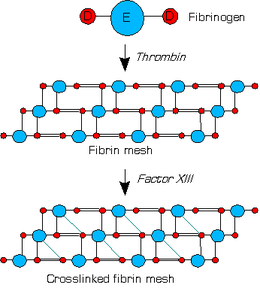Factor XIII

| coagulation factor XIII, A1 polypeptide | |
|---|---|
| Identifiers | |
| Symbol | F13A1 |
| Alt. symbols | F13A |
| Entrez | 2162 |
| HUGO | 3531 |
| OMIM | 134570 |
| RefSeq | NM_000129 |
| UniProt | P00488 |
| Other data | |
| Locus | Chr. 6 p24.2-p23 |
| coagulation factor XIII, B polypeptide | |
|---|---|
| Identifiers | |
| Symbol | F13B |
| Entrez | 2165 |
| HUGO | 3534 |
| OMIM | 134580 |
| RefSeq | NM_001994 |
| UniProt | P05160 |
| Other data | |
| Locus | Chr. 1 q31-q32.1 |
Factor XIII or fibrin stabilizing factor is an enzyme (EC 2.3.2.13) of the blood coagulation system that crosslinks fibrin. Deficiency of this factor (FXIIID) affects clot stability. FXIIID, while generally rare, does occur, with Iran having the highest global incidence of the disorder with 473 cases. The city of Khash, located in Sistan and Balochistan provinces, has the highest incidence in Iran, with a high rate of consanguineous marriage.[1]
Function
Factor XIII is a transglutaminase that circulates in the plasma as a heterotetramer of two catalytic A subunits and two carrier B subunits. When thrombin has converted fibrinogen to fibrin, the latter forms a proteinaceous network in which every E-unit is crosslinked to only one D-unit. Factor XIII is activated by thrombin into factor XIIIa; its activation into Factor XIIIa requires calcium as a cofactor. A cleavage by thrombin between residue Arg37 and Gly38 on the N-terminus of the A subunit, leads to the release of the activation peptide (MW 4000 da). In the presence of calcium the carrier subunits dissociate from the catalytic subunits, leading to a 3D change in conformation of factor XIII and hence the exposure of catalytic cysteine residue. Upon activation by thrombin, factor XIIIa acts on fibrin to form γ-glutamyl-Є-lysyl amide cross links between fibrin molecules to form an insoluble clot.
Discovery
FXIII is known also as Laki-Lorand factor, after Kalman Laki and Laszlo Lorand, the scientists who first proposed its existence in 1948.[2] A 2005 conference recommended standardization of nomenclature.[3]
Genetics
Zymogen factor XIII is a 320kDa glycoprotein tetramer consisting of twice two subunits (2 A and 2 B),[3] the genes for which are on different chromosomes:
- A subunit (6p25-p24). The transglutaminase part; this adds an alkyl group to the nitrogen on a glutamine residue, which binds in turn with a lysine on the other chain. The molecular weight of the A chain is approximately 83kDa.
- B subunit (1q31-q32.1). This has no clear enzymatic activity, and may serve as a carrier for the A subunit. The molecular weight of the B chain is approximately 76.5kDa.
Structure
Factor XIII has two forms: a plasmatic form that flows freely in the blood plasma, and a cellular form carried inside platelet alpha-granules.
The cellular form is a dimer of two identical subunits, FXIII-A, each consisting of an activation peptide that is cleaved upon activation, a β-sandwich domain, a catalytic transglutaminase domain and two β-barrel domains.
The plasmatic form includes two additional identical subunits, FXIII-B, that is released in a calcium-dependent manner upon activation peptide cleavage. Each FXIII-B is both inhibitory and serves as a plasma carrier, and consists of ten repetitive sushi domains held together by two internal disulfide bond each. During circulation, this subunit binds fibrinogen. [4]
Physiology
Typical concentrations of FXIII in plasma is 10 μg/ml (2A2B heterodimer), while the concentration of free B chain is 22 μg/ml. FXIII has a long half-life, ranging from 5 to 9 days. It is present in plasma, platelets, and monocytes, as well as macrophages and bone marrow precursors of these cell types.[3]
A clot that has not been stabilized by FXIIIa is soluble in 5 mol/L urea, while a stabilized clot is resistant to this phenomenon.[2]
Diagnostic use
Factor XIII levels are not measured routinely, but may be considered in patients with an unexplained bleeding tendency. As the enzyme is quite specific for monocytes and macrophages, determination of the presence of factor XIII may be used to identify and classify malignant diseases involving these cells.[3]
See also
Dorgalaleh A, Naderi M, Hosseini MS, Alizadeh S, Hosseini S, Tabibian S, et al.,. Factor XIII Deficiency in Iran: A Comprehensive Review of the Literature. Seminars in thrombosis and hemostasis; 2015.
References
- ↑ Dorgalaleh A, Naderi M, Hosseini MS, Alizadeh S, Hosseini S, Tabibian S, et al. (2015). "Factor XIII Deficiency in Iran: A Comprehensive Review of the Literature. Seminars in thrombosis and hemostasis;". 41 (3 (41)): 323–329.
- 1 2 Laki K, Lóránd L (September 1948). "On the Solubility of Fibrin Clots". Science. 108 (2802): 280. doi:10.1126/science.108.2802.280. PMID 17842715.
- 1 2 3 4 Muszbek L, Ariëns RA, Ichinose A (January 2007). "Factor XIII: recommended terms and abbreviations". J. Thromb. Haemost. 5 (1): 181–3. doi:10.1111/j.1538-7836.2006.02182.x. PMID 16938124.
- ↑ Komáromi I, Bagoly Z, Muszbek L (Jan 2011). "Factor XIII: novel structural and functional aspects". Journal of Thrombosis and Haemostasis. 9 (1): 9–20. doi:10.1111/j.1538-7836.2010.04070.x. PMID 20880254.